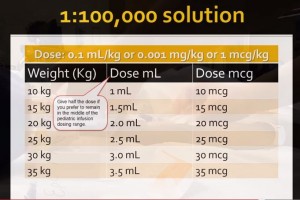Pediatric Pulse Dose Pressor Administration, 2014 YouTube video by Dr. Larry Mellick.
Published on Sep 29, 2014
In this video we demonstrate the administration of intravenous epinephrine as pulse doses instead of a continuous infusion. This technique can be used for hypotensive anaphylaxis, as intermittent doses before the pressor infusion is started, or for unstable patients about to be intubated. Volume replacement typically will precede these pulse doses for most conditions.
o.09 to 0.29: Clinical Situation: Pt is an 11 year old female with end-stage renal disease secondary to FSGS and she has severe cardiomyopathy. She has hypotension, altered mental status, hypoglycemia, and hyperkalemia. Hypotension is unresponsive to fluid boluses and a norepinephrine drip is pending.
0.45 to : We’re going to do pulse dose epinephrine. Take one mL of 1 to 10,000 epinephrine and put it in 9 mL of normal saline and mix well. And your syringe will now have a concentration of 10 mcg/mL. [Be sure and label your syringe before you lay it down.]
1.14: Here is the Pediatric pulse dose that we will use and this will be like an intermittent epinephrine drip:
1:35 to 2:02: “The good thing about pulse dose epi is that it allows you to buy time until you get the epinephrine infusion or the norepinephrine infusion started. You can also do the pulse dose pressors if you have a patient in anaphylaxis and you feel like you need to begin IV epinephrine. So if a hypotensive patient in anaphylaxis, you can also give the pulse dose pressor. It is giving the high end of an epinephrine infusion, 1 mcg/kg/min but you are giving it in intermittent little boluses.”
The chart below refers to an IV pediatric Epinephrine infusion.
1:40: [Remember that] pulse dose epinephrine “Typically follows volume replacement!”
1:45: “You can also do the pulse dose pressor if you have a patient in anaphylaxis and you feel like you need to begin IV epinephrine. So, for the hypotensive patient in anaphylaxis, you can also do the pulse dose pressor. It is giving the high end of an epinphrine infusion – 1 microgram per kilogram per minute but you are giving it with intermitent boluses.”
2:08 put in figure3 here or on line below.
2:44 Put figure 4 here or below
2:45: “And then we’ll do 0.1 mL/kg which is 1 mcg/kg. [So our patient is 30 kg and so we will give 0.1 mL/kg x 30 kg = 3 mL slow IV push.]
2:52: The nurse gives the medicine and states “3 mLs [given].” And the pressure comes up to a satisfactory level
3:15: “The other benefit on this is that if you have an unstable patient, and you are getting ready to intubate and but you are afraid that your intubation drugs are going to cause the patient to crash, a little bolus of this will protect [the patient] sometimes.”
3:42: For about five minutes the initial dose worked and then the pressure went down so we give more.
3:45 Note the important difference between adult dosing of an epinephrine infusion and the pediatric dosing of an epinephrine infusion.
Adult Dose of IV epinephrine infusion: 
The 2 to 10 microgram per minute adult infusion rate is for profound bradycardia or hypotension. p 45* The higher dose on the chart (in smaller letters) is for post-cardiac arrest hypotension. p 8* *2010 Handbook of Emergency Cardiovascular Care for Healthcare Providers.
4:02: The balloon in the chart below says “Give half the dose if you prefer to remain in the middle of the pediatric dosing range [for your IV push dose epi].”
4:20: And the patient’s pressure goes back up after the second dose if IV push epinephrine given above. “And we’ll have to do this every five to ten minutes probably until they get the [constant infusion pressor] drip started up in the ICU.”
4:30: “So in summary when you are doing an epinephrine infusion you are doing 0.1 to 1 mcg/kg/min. When you are doing the pulse dose pressor, you are really doing 1 mcg/kg/min which is the high end of an infusion of an infusion of epinephrine.
In the comments following the video, Dr. Mellick states that the patient was stabilized and went to the ICU and recieved a central line in the femoral vein with a constant infusion pressor.
Note that for a norepinephrine drip, the pediatric PALS dosage from the 2010 Handbook of Emergency Cardiovascular Care for Healthcare Providers (p 100) states: “Begin at rates of 0.1 to 2 mcg/kg per minute; adjust infusion rate to achieve desired change in blood pressure and systemic perfusion.”










